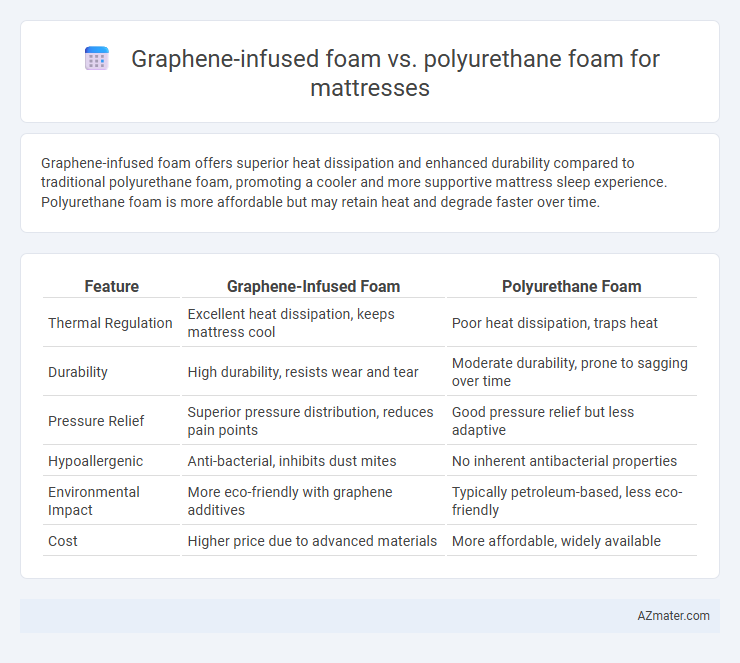Graphene-infused foam offers superior heat dissipation and enhanced durability compared to traditional polyurethane foam, promoting a cooler and more supportive mattress sleep experience. Polyurethane foam is more affordable but may retain heat and degrade faster over time.
Table of Comparison
| Feature | Graphene-Infused Foam | Polyurethane Foam |
|---|---|---|
| Thermal Regulation | Excellent heat dissipation, keeps mattress cool | Poor heat dissipation, traps heat |
| Durability | High durability, resists wear and tear | Moderate durability, prone to sagging over time |
| Pressure Relief | Superior pressure distribution, reduces pain points | Good pressure relief but less adaptive |
| Hypoallergenic | Anti-bacterial, inhibits dust mites | No inherent antibacterial properties |
| Environmental Impact | More eco-friendly with graphene additives | Typically petroleum-based, less eco-friendly |
| Cost | Higher price due to advanced materials | More affordable, widely available |
Introduction to Mattress Foams
Graphene-infused foam and polyurethane foam represent two advanced materials used in mattress construction, each offering distinct properties for comfort and durability. Polyurethane foam has long been valued for its flexibility, affordability, and support, making it a standard choice in many mattresses. Graphene-infused foam incorporates graphene particles to enhance thermal conductivity and antimicrobial properties, providing improved heat dissipation and hygiene compared to traditional polyurethane foam.
What is Graphene-Infused Foam?
Graphene-infused foam is a cutting-edge material that incorporates graphene, a single layer of carbon atoms arranged in a hexagonal lattice, into traditional memory or polyurethane foams to enhance thermal conductivity, durability, and antibacterial properties. This innovative infusion results in a mattress foam that effectively dissipates heat, providing a cooler sleeping surface compared to standard polyurethane foam, which often traps heat and reduces comfort. The enhanced structural strength and antimicrobial benefits of graphene-infused foam contribute to a longer-lasting, more hygienic mattress experience.
Understanding Polyurethane Foam
Polyurethane foam, a versatile and widely used material in mattresses, offers excellent support and durability due to its open-cell structure that provides breathability and pressure relief. Unlike graphene-infused foam, polyurethane foam typically lacks enhanced thermal conductivity, which can affect heat dissipation and overall sleep comfort. Understanding the chemical composition and density variations of polyurethane foam is essential for evaluating its performance in different mattress applications and comparing it to advanced materials like graphene-infused foam.
Key Differences Between Graphene-Infused and Polyurethane Foams
Graphene-infused foam offers enhanced thermal conductivity and superior heat dissipation compared to traditional polyurethane foam, resulting in a cooler sleep experience. It also provides increased durability and antimicrobial properties due to graphene's natural resistance to bacteria and wear. Polyurethane foam, while widely used for its cushioning and affordability, typically lacks the advanced cooling and longevity benefits found in graphene-infused alternatives.
Thermal Regulation: Graphene-Infused vs Polyurethane Foam
Graphene-infused foam outperforms polyurethane foam in thermal regulation by efficiently dissipating heat due to graphene's superior thermal conductivity, maintaining a cooler sleep surface. Polyurethane foam tends to retain body heat, often causing overheating and discomfort during sleep cycles. The enhanced heat dispersion properties of graphene-infused foam contribute to improved breathability and a more stable sleeping temperature throughout the night.
Durability and Longevity Comparison
Graphene-infused foam exhibits superior durability compared to traditional polyurethane foam due to its enhanced thermal conductivity and resistance to wear and tear, which helps maintain mattress structure over time. Polyurethane foam, while cost-effective, tends to break down faster under repeated pressure, leading to sagging and reduced support within a few years. The integration of graphene nanoparticles significantly extends the longevity of foam mattresses by minimizing heat retention and degradation risks commonly associated with polyurethane foam.
Support and Comfort Levels
Graphene-infused foam offers superior support by enhancing pressure distribution and maintaining consistent firmness through its advanced thermal conductivity, which helps regulate body temperature for improved comfort. Polyurethane foam provides a softer feel with varying support levels depending on density but may retain more heat, potentially impacting comfort during extended use. The integration of graphene significantly elevates durability and breathability, making it ideal for sleepers seeking a balance of firm support and cooling comfort.
Health and Safety Considerations
Graphene-infused foam mattress offers enhanced antimicrobial properties and better temperature regulation, reducing the growth of harmful bacteria and allergens for improved health safety. Polyurethane foam, while widely used, may off-gas volatile organic compounds (VOCs) that can trigger respiratory issues or allergies in sensitive individuals. Choosing graphene-infused foam supports a safer sleep environment by minimizing exposure to toxins and promoting cleaner air quality.
Cost and Value Analysis
Graphene-infused foam mattresses typically command a higher price than traditional polyurethane foam due to advanced material costs and enhanced durability. While polyurethane foam offers a more budget-friendly option, graphene-infused foam provides superior thermal conductivity and pressure relief, potentially extending mattress lifespan and comfort levels. Cost analysis favors polyurethane foam for short-term affordability, whereas graphene-infused foam delivers better long-term value through its combined benefits and reduced wear.
Which Mattress Foam is Right for You?
Graphene-infused foam offers superior heat dissipation and antimicrobial properties, making it ideal for sleepers who prioritize cooling and hygienic surfaces. Polyurethane foam provides greater affordability and varied firmness options, suitable for budget-conscious buyers seeking customizable support. Choosing the right mattress foam depends on individual needs for temperature regulation, durability, and comfort preferences.

Infographic: Graphene-infused foam vs Polyurethane foam for Mattress
 azmater.com
azmater.com